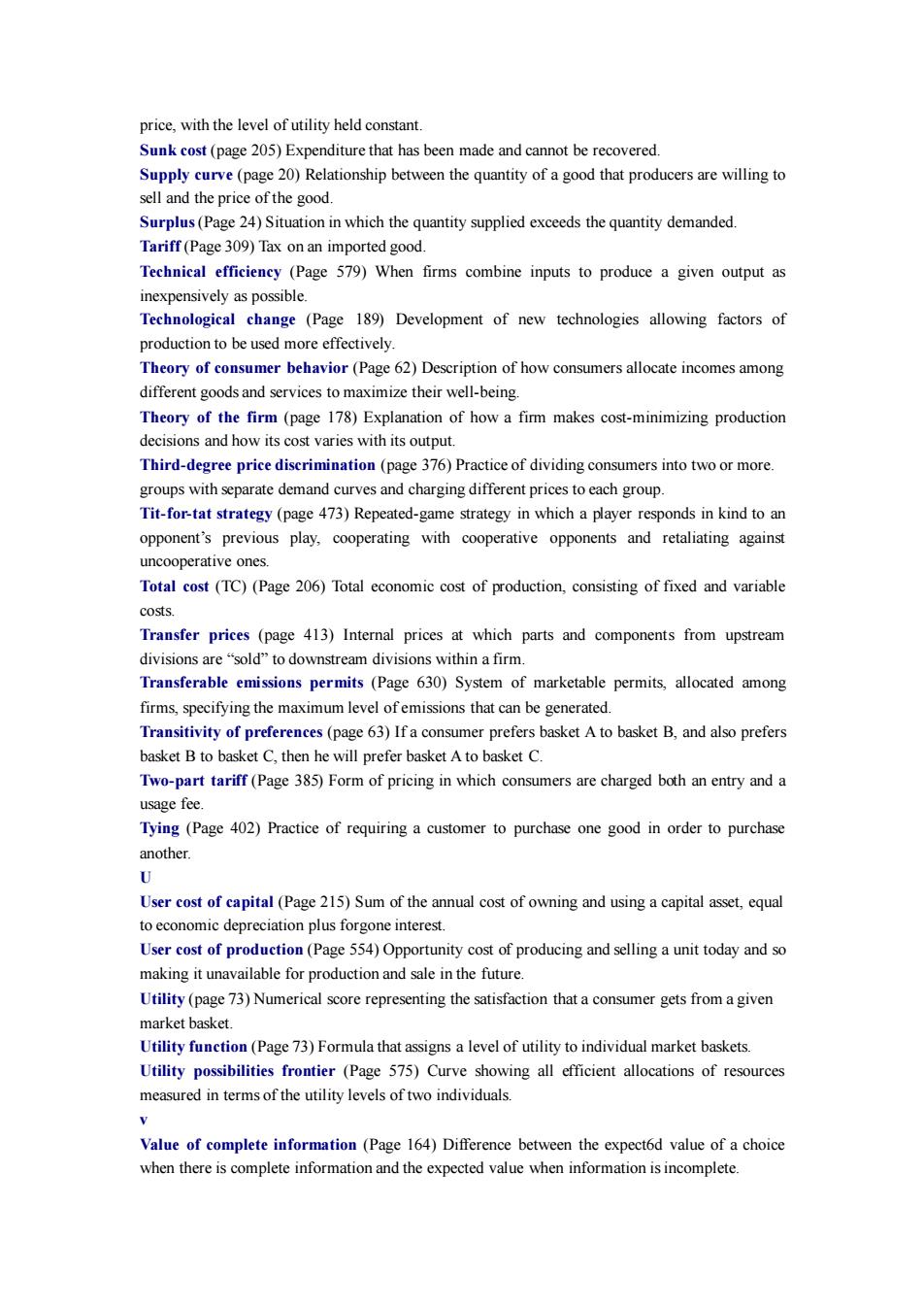正在加载图片...

price,with the level of utility held constant. (page 205)Expenditure that has been made and canot be recovered sell and the price ofthe good Surplus(Page 24)Situation in which the quantity supplied exceeds the quantity demanded. Tariff(Page309)Tax on an imported good. Technical efficiency (Page 579)When firms combine inputs to produce a given output as Technological change (Page 189)Development of new technologies allowing factors of production to be used more effectively. Theory of consumer behavior(Page 62)Description of how consumers allocate incomes among different goods and services to maximize their well-being. Theryof thefirm (page 178)Explanation of how a fim makes cost-minimizing production decisions and how its cost varies with its output Third-degree price diserimination(page 376)Practice of dividing consumers into two or more. groups with separate demand curves and charging different prices to each group. Tit-for-tat strategy (page 473)Repeated-game strategy in which a player responds in kind to an play,cooperating with cooperative opponents and retaliating agains rative one Total cost (TC)(Page 206)Total economic cost of production,consisting of fixed and variable C055 Transfer prices (page 413)Internal prices at which parts and components from upstream divisions divisio Transferable perm e 630)Sys of marketable permits,allocated among firms,specifying the maximum level of emissions that can be generated Transitivity of preferences(page 63)If a consumer prefers basket Ato basket B.and also prefers basket B to basket C,then he will prefer basket A to basket C. Two-part tariff(Page 385)Form of pricing in which consumers are charged both an entry and a usage fee. Tymg ()Practice t purchase one order to purchase another. 0 User cost of capital (Page 215)Sum of the annual cost of owning and using a capital asset.equal tio(Page 554)Opportunity cost of producing and sellinga unit today andso making it unavailable for production and sale in the future. Utility(page 73)Numerical score representing the satisfaction that a consumer gets from a given market basket. Utility function(Page 73)Formula that assigns a level of utility to individual market baskets. Utility possibilities frontier(Page 575)C sho wing all。 efficient allocations of resources measured in termsof the utility levels of two individuals Value of complete information (Page 164)Difference between the expect6d value of a choice when there is complete information and the expected value when information is incomplete. price, with the level of utility held constant. Sunk cost (page 205) Expenditure that has been made and cannot be recovered. Supply curve (page 20) Relationship between the quantity of a good that producers are willing to sell and the price of the good. Surplus (Page 24) Situation in which the quantity supplied exceeds the quantity demanded. Tariff (Page 309) Tax on an imported good. Technical efficiency (Page 579) When firms combine inputs to produce a given output as inexpensively as possible. Technological change (Page 189) Development of new technologies allowing factors of production to be used more effectively. Theory of consumer behavior (Page 62) Description of how consumers allocate incomes among different goods and services to maximize their well-being. Theory of the firm (page 178) Explanation of how a firm makes cost-minimizing production decisions and how its cost varies with its output. Third-degree price discrimination (page 376) Practice of dividing consumers into two or more. groups with separate demand curves and charging different prices to each group. Tit-for-tat strategy (page 473) Repeated-game strategy in which a player responds in kind to an opponent’s previous play, cooperating with cooperative opponents and retaliating against uncooperative ones. Total cost (TC) (Page 206) Total economic cost of production, consisting of fixed and variable costs. Transfer prices (page 413) Internal prices at which parts and components from upstream divisions are “sold” to downstream divisions within a firm. Transferable emissions permits (Page 630) System of marketable permits, allocated among firms, specifying the maximum level of emissions that can be generated. Transitivity of preferences (page 63) If a consumer prefers basket A to basket B, and also prefers basket B to basket C, then he will prefer basket A to basket C. Two-part tariff (Page 385) Form of pricing in which consumers are charged both an entry and a usage fee. Tying (Page 402) Practice of requiring a customer to purchase one good in order to purchase another. U User cost of capital (Page 215) Sum of the annual cost of owning and using a capital asset, equal to economic depreciation plus forgone interest. User cost of production (Page 554) Opportunity cost of producing and selling a unit today and so making it unavailable for production and sale in the future. Utility (page 73) Numerical score representing the satisfaction that a consumer gets from a given market basket. Utility function (Page 73) Formula that assigns a level of utility to individual market baskets. Utility possibilities frontier (Page 575) Curve showing all efficient allocations of resources measured in terms of the utility levels of two individuals. v Value of complete information (Page 164) Difference between the expect6d value of a choice when there is complete information and the expected value when information is incomplete